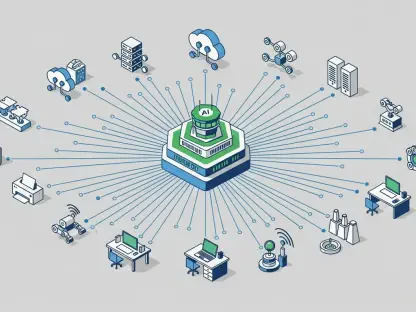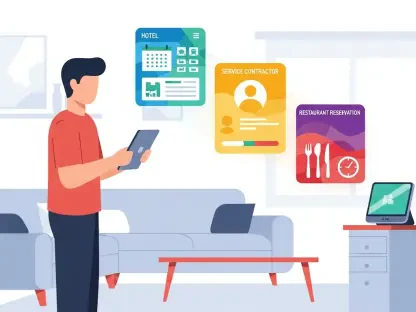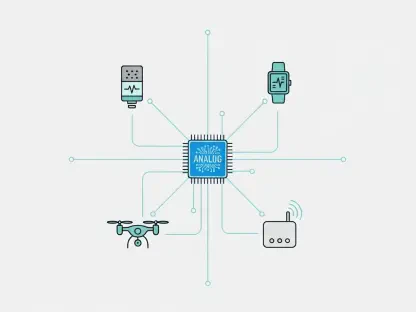Imagine a world where businesses operate at peak efficiency, seamlessly adapting to market shifts while employees dedicate their energy to creative and strategic endeavors rather than mundane tasks, and this vision is becoming a reality through hyperautomation. This innovative approach merges Artificial Intelligence (AI) and Robotic Process Automation (RPA) to revolutionize organizational workflows. Far surpassing traditional automation, which typically handles repetitive jobs like data entry or basic reporting, hyperautomation introduces a layer of cognitive intelligence. It empowers systems to not only execute tasks but also learn from data, adapt to new scenarios, and optimize processes in real time. This isn’t merely about accelerating operations; it’s about fundamentally reshaping how companies function in a fiercely competitive landscape. As industries face unrelenting pressure to innovate, hyperautomation emerges as a vital tool, offering both immediate efficiency gains and long-term scalability. Its potential to transform spans across sectors, promising a future where technology and human ingenuity work in perfect harmony.
Understanding Hyperautomation
Defining the Concept
Hyperautomation represents a significant leap forward in business technology, combining the precision of Robotic Process Automation with the adaptive intelligence of Artificial Intelligence to create systems that do more than follow pre-set rules. Unlike earlier forms of automation that were limited to structured, repetitive tasks, this approach enables machines to interpret complex, unstructured data and make informed decisions. In today’s high-stakes business environment, where agility is paramount, hyperautomation provides a critical edge by allowing organizations to streamline operations without sacrificing flexibility. It’s a comprehensive strategy that integrates various tools to automate end-to-end processes, reducing human intervention while enhancing accuracy. This technology isn’t just a trend; it’s a response to the growing need for resilience in the face of rapid change, ensuring companies can pivot quickly without being bogged down by outdated systems or manual workloads.
At the heart of hyperautomation lies a synergy of advanced technologies such as machine learning, natural language processing, and intelligent document processing, which collectively push automation beyond basic execution. Machine learning algorithms enable systems to identify patterns and predict outcomes, while natural language processing allows for the interpretation of human communication, such as emails or voice commands. Intelligent document processing transforms unstructured content from invoices or contracts into actionable data, eliminating tedious manual entry. Together, these components create a dynamic framework where processes are not only automated but also continuously refined based on real-time insights. This capability to self-improve sets hyperautomation apart, making it an indispensable asset for businesses aiming to maintain a competitive stance. By reducing errors and accelerating workflows, it frees up valuable time for strategic thinking, positioning organizations to thrive amidst evolving market demands.
Core Technologies
The technological foundation of hyperautomation is built on a suite of sophisticated tools that work in tandem to elevate automation to new heights. Machine learning stands as a cornerstone, enabling systems to analyze vast datasets, detect inefficiencies, and suggest optimizations without explicit programming. Natural language processing complements this by allowing machines to understand and generate human-like text, facilitating seamless interaction with users and handling tasks like customer inquiries or document summarization. Additionally, intelligent document processing leverages optical character recognition and AI to extract meaningful information from unstructured sources such as scanned forms or handwritten notes. These technologies converge to create a robust automation ecosystem that doesn’t just perform tasks but evolves with each interaction, ensuring processes remain efficient and relevant in a fast-paced business world.
Beyond these, hyperautomation incorporates process mining and analytics to map out existing workflows and uncover hidden bottlenecks, providing a clear blueprint for improvement. These tools create virtual models of operations, often referred to as Digital Twins, which simulate real-world processes for testing and refinement. This predictive capability allows decision-makers to prioritize automation efforts where they’ll have the most impact, minimizing waste and maximizing returns. Furthermore, the integration of adaptive algorithms ensures that systems can adjust to unexpected changes—whether it’s a shift in user behavior or a new regulatory requirement—without requiring extensive reconfiguration. This adaptability is crucial for maintaining operational continuity, especially in industries prone to disruption. By blending these cutting-edge technologies, hyperautomation delivers a level of sophistication that traditional methods simply cannot match, paving the way for smarter, more responsive business environments.
Key Features and Innovations
Cutting-Edge Capabilities
One of the standout features of hyperautomation is its use of Process Discovery and Digital Twins, which provide a detailed, real-time view of organizational workflows. Process mining tools analyze data from various systems to map out how tasks are performed, revealing inefficiencies or delays that might go unnoticed. These insights are then used to construct a Digital Twin of the Organization—a virtual replica that simulates operations for testing and optimization. This allows leaders to predict potential issues, experiment with solutions, and implement automation where it’s most needed, all without disrupting live processes. Adaptive smart bots also play a pivotal role, going beyond traditional RPA by visually interpreting interfaces and adjusting to changes autonomously. Their ability to learn from interactions ensures they remain effective even as systems or user needs evolve, marking a significant advancement in automation technology.
Another innovative aspect lies in the continuous improvement mechanisms embedded within hyperautomation systems, ensuring they don’t just perform tasks but enhance their own efficiency over time. Smart bots and workflows are designed with feedback loops that monitor performance metrics, identify errors, and incorporate human corrections to refine their behavior. This self-learning capability reduces the need for manual updates, saving time and resources while maintaining high accuracy. Additionally, the emphasis on scalability means these systems can handle increasing workloads without compromising speed or quality, making them ideal for growing enterprises. By integrating such forward-thinking features, hyperautomation not only addresses current operational needs but also anticipates future challenges, offering a sustainable solution that evolves alongside the business landscape. This blend of foresight and flexibility underscores its transformative potential.
Accessibility and Feedback
Hyperautomation also shines in its accessibility, thanks to low-code and no-code platforms that democratize the technology for non-technical users. These intuitive tools allow employees across departments to design automations by describing processes in plain language, bypassing the need for deep coding expertise. This inclusivity accelerates deployment, as business units can tailor solutions to their specific needs without waiting for IT support. For instance, a marketing team might automate campaign tracking, while a finance department streamlines expense reporting, all through user-friendly interfaces. Such empowerment not only boosts productivity but also fosters a culture of innovation, as more minds contribute to process improvement. By lowering the technical barrier, hyperautomation ensures that its benefits are not confined to specialized teams but are accessible throughout an organization, driving widespread efficiency.
Equally important are the continuous feedback mechanisms that enable hyperautomation systems to self-correct and optimize over time, ensuring sustained performance. These systems are equipped with monitoring tools that track key indicators like processing speed or error rates, flagging anomalies for review. When human intervention occurs—say, to correct a misinterpretation—the system learns from the input, adjusting its algorithms to prevent similar mistakes. This iterative process minimizes downtime and enhances reliability, particularly in high-volume environments where precision is critical. Moreover, the data gathered from these feedback loops provides valuable insights for refining broader strategies, helping leaders make informed decisions about scaling or modifying automations. This focus on perpetual improvement sets hyperautomation apart as a technology that doesn’t just solve problems but anticipates and prevents them, solidifying its role as a cornerstone of modern business operations.
Transforming Business Operations
Industry Applications
Hyperautomation’s real-world impact is evident across diverse sectors, where it addresses unique challenges with tailored solutions, proving its versatility as a transformative force. In banking and finance, institutions leverage this technology to expedite loan processing, enhance fraud detection through AI-driven anomaly analysis, and ensure compliance with ever-changing regulations. Healthcare organizations benefit by automating patient scheduling, billing, and record management, significantly reducing administrative burdens and allowing staff to focus on care delivery. Retail and e-commerce businesses gain agility, using hyperautomation to manage inventory and respond to market trends while keeping costs in check. These examples highlight how the technology adapts to specific industry demands, delivering measurable improvements in efficiency and customer satisfaction, and demonstrating its capacity to reshape operational models across the board.
Beyond these sectors, hyperautomation proves equally impactful in areas like expense management and procurement, where real-time validation and policy enforcement curb fraud and enhance transparency. By integrating AI with RPA, companies can instantly verify transactions against compliance rules, flagging discrepancies before they escalate into costly issues. This proactive approach not only saves resources but also builds trust in financial processes. Additionally, in manufacturing, hyperautomation optimizes supply chain logistics by predicting demand fluctuations and automating reorder processes, minimizing delays. The ability to customize solutions for such varied contexts underscores the technology’s flexibility, making it a powerful ally for any industry grappling with complex, repetitive tasks. As more businesses recognize these applications, adoption continues to grow, signaling a shift toward intelligent, data-driven operations that prioritize both speed and precision in addressing sector-specific pain points.
Benefits and Adaptability
The immediate benefits of hyperautomation are striking, with many organizations reporting dramatic reductions in processing times—often by as much as 90%—alongside significant drops in error rates. These efficiency gains translate into cost savings and faster service delivery, giving companies a competitive edge in time-sensitive markets. Case studies across industries reveal that tasks once taking hours, such as data reconciliation or customer query handling, are now completed in minutes, thanks to the seamless integration of AI and RPA. This speed doesn’t come at the expense of quality; instead, it enhances reliability by minimizing human error in repetitive processes. For businesses under pressure to deliver results quickly, these tangible improvements provide a clear justification for investment, proving that hyperautomation can drive substantial operational advancements from the outset.
Deeper still, the adaptability of hyperautomation equips organizations to navigate constant change without the delays associated with traditional system updates or manual reprogramming. Systems powered by this technology can respond to new data inputs, regulatory shifts, or customer behavior changes in real time, ensuring continuity even in volatile conditions. This resilience is particularly valuable in uncertain economic climates, where flexibility can mean the difference between stagnation and growth. Moreover, by automating routine tasks, hyperautomation fosters a human-centric workplace, empowering employees to shift focus toward strategic initiatives and creative problem-solving. This not only boosts productivity but also enhances job satisfaction, as teams engage in more meaningful work. The dual advantage of operational agility and workforce empowerment positions hyperautomation as a catalyst for long-term organizational strength, capable of evolving with future challenges.
Challenges and Future Potential
Barriers to Adoption
Implementing hyperautomation is not without its obstacles, with integration complexity standing out as a primary challenge for many organizations embarking on this journey. Merging AI, RPA, and existing legacy systems into a unified framework often requires significant technical expertise and resources, especially in environments with outdated infrastructure. The process can be further complicated by data silos or incompatible platforms, leading to delays and increased costs. Beyond technology, change management emerges as a critical hurdle, as employees may resist adoption due to fears of job displacement or skepticism about automated decision-making. Addressing these concerns through transparent communication and comprehensive training is essential to build trust and ensure smooth transitions, highlighting the need for a strategic approach that balances technological and human factors in equal measure.
Another barrier lies in ongoing maintenance and the talent gap that can hinder hyperautomation’s full potential, requiring sustained effort to keep systems effective over time. Intelligent bots and AI models demand regular monitoring and periodic retraining to stay aligned with evolving business needs or data patterns, which can strain resources if not planned adequately. Simultaneously, the scarcity of professionals skilled in both process design and AI engineering poses a significant challenge, often slowing implementation timelines. Companies must invest in upskilling existing staff or recruiting specialized talent to bridge this gap, a process that can be time-intensive and costly. Despite these hurdles, the right strategies—such as partnering with technology providers or fostering internal learning programs—can mitigate risks, ensuring that hyperautomation delivers on its promise. Overcoming these barriers is not just feasible but necessary for businesses aiming to stay ahead in a rapidly digitizing world.
Strategic Vision and Evolution
Hyperautomation is increasingly viewed as a strategic imperative, moving beyond mere task automation to a model of intelligent orchestration that anticipates and addresses needs proactively. This vision involves systems that not only execute workflows but also predict demand, dynamically adjust resources, and alert managers to potential disruptions before they occur. Such proactive orchestration represents a shift from reactive fixes to forward-thinking solutions, enabling businesses to stay ahead of challenges rather than merely responding to them. The role of low-code tools further amplifies this strategic importance by empowering smaller teams or non-technical staff to innovate, ensuring that automation isn’t confined to large IT departments. This democratization of technology fosters a culture of agility, positioning hyperautomation as a cornerstone for sustained growth and competitiveness across all business scales.
Looking to the horizon, the evolution of hyperautomation promises even greater integration with generative AI, potentially expanding its scope to handle complex tasks like drafting documents, summarizing discussions, or even negotiating agreements. This convergence could redefine the boundaries of automation, creating systems that not only process data but also generate creative outputs or strategic insights. As these capabilities mature, the focus will likely shift toward predictive analytics, where systems anticipate market trends or operational needs with unprecedented accuracy. The trajectory suggests a future where hyperautomation becomes an integral part of decision-making, blending human judgment with machine precision to tackle challenges in innovative ways. This ongoing transformation underscores the technology’s potential to shape the future of work, offering a glimpse into a landscape where adaptability and intelligence drive every aspect of business operations.









